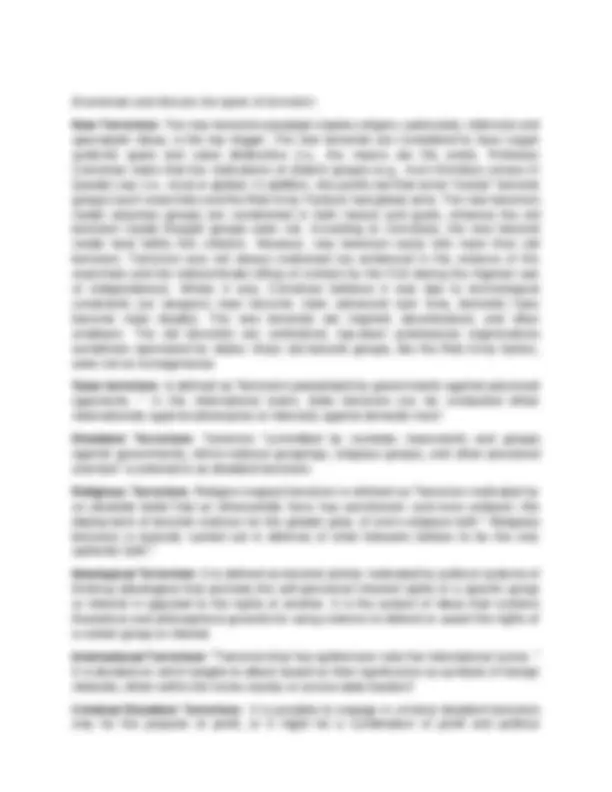




Study with the several resources on Docsity

Earn points by helping other students or get them with a premium plan


Prepare for your exams
Study with the several resources on Docsity

Earn points to download
Earn points by helping other students or get them with a premium plan
Community
Ask the community for help and clear up your study doubts
Discover the best universities in your country according to Docsity users
Free resources
Download our free guides on studying techniques, anxiety management strategies, and thesis advice from Docsity tutors
This material gives understanding why terrorism is considered a major threat in the Philippines.
Typology: Study notes
1 / 4

This page cannot be seen from the preview
Don't miss anything!



Why Terrorism considered as a major threat in our country? Terrorism has two basic trends:
Since the 1970s, Islamists and communist separatists have planned and conducted several attacks around the Philippines, with the deadliest on Mindanao. Between 1969 and 2010, the Philippines was subjected to around 593 attacks of varied degrees, according to the Database of Worldwide Terrorism Incidents. From 2000 through 2007, Islamic militants bombed Filipino citizens, killing 400 and injuring over a thousand. In over 40 years of conflict with the government, leftist radicals have killed an estimated 120,000 fatalities. Associated Press estimated in November 2016 that the NPA had 3,800 guerillas active in the first half of 2016. The terrorist threat in the Philippines has evolved from homicides, kidnappings, and armed attacks to a fatal increase in suicide bombers in recent years. Six suicide bombers struck the country between July 2018 and November 2019, with signs of more planned but thwarted. On May 8, 2021, members of the Bangsamoro Islamic Freedom Fighters (BIFF) occupied the town market in Datu Paglas, Maguindanao, forcing families to leave. A local officer then revealed that only 20 militants invaded the area. Despite a brief gunfight, no one was hurt or property damaged. A Philippine military force drove the BIFF insurgents out of town. On May 11, government soldiers confronted the gang in Buluan, killing five BIFF terrorists. On the same day, President Duterte visited Maguindanao, urging local officials to help him defeat terrorism in the province. He said BIFF's “full-blown terrorism” hampered peace. Between January 2020 and December 2020, the AFP captured or killed 7,000 New People's Army (NPA) rebels (CPP). According to then-AFP chief Lieutenant General Gilbert Gapay, 187 ASG militants, 339 Bangsamoro Islamic Freedom Fighters (BIFF) members, and 61 Maute terrorists were killed within the same period. Western Mindanao Command (WestMinCom) revealed on July 8, 2021 that military operations had killed approximately 300 terrorists in the preceding six months—114 ASG fighters, 104 BIFF members, 11 high-value targets, and 64 New People's Army members (NPA).
motivation. For example, typical organized criminals accrue profits to fund their illegal activity and to support their own interests, whereas criminal-political organizations accrue revenues to ensure the continuation of their political movements. Gender-Selective Terrorism: Terrorism directed against either men or women in an enemy population based on their gender identity or expression. Because males are regarded to be a threat as potential soldiers or sources of dissent, systematic violence is focused towards them. A hostile group's cultural identity is destroyed or terrorized into submission when systematic violence is aimed towards its women.